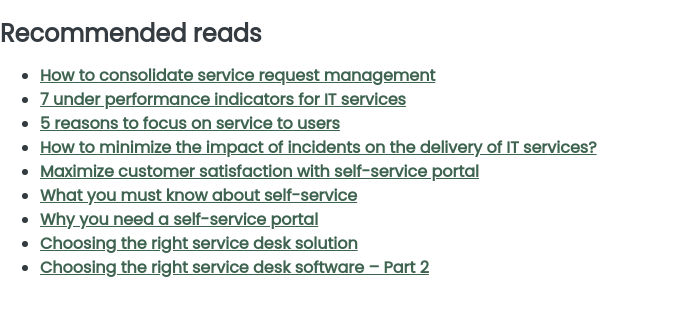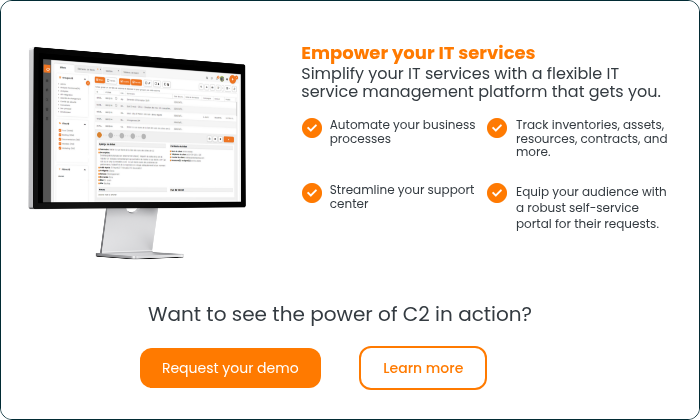The short answer: Enterprise Service Management (ESM) takes the principles of IT Service Management (ITSM) and applies them to other business activities. So, for example, you can apply service management methodologies to facilities, marketing, or finance operations. The goal of ESM is to standardize workflows in those departments into services, which will boost efficiency and improve the satisfaction of the internal and external customers of those services.
There is more you’ll want to know if you’re considering adopting an ESM system at your organization. So keep reading, and we’ll unpack Enterprise Service Management further, explain exactly how it builds off of ITSM, how it differs from ITSM, and how adopting ESM practices can benefit your organization.
The longer answer to “What is ESM?”
ESM as a practice emerged as a direct result of the success of IT Service Management. If you’re not already familiar with ITSM, that is OK. That doesn’t need to stop you from considering an ESM system.
As the names suggest, the common component of each is service management. Service management structures a given business practice into a customer and provider relationship. It further wants to reduce the complexity of that relationship by packaging what customers value into services that you can easily and efficiently deliver. Those services might be information technology, but an ESM methodology says it could just as easily be a facilities service or a security one.
Once workflows are standardized, it becomes much easier to monitor, analyze, and modify your business practices. Those processes taken together are called service lifecycle management, the final key component of ESM.
The relationship between ESM and ITSM
So both ITSM and ESM seek to structure business activities as services requested by customers and delivered by providers. Those customers could be internal to the organization or external. The service could be information technology, or it could be another enterprise activity. But no matter what, a service is still at the core of these business practices, and that service needs to be properly designed, delivered, supported and improved. That is why no matter whether you’re following ESM or ITSM practices, you’ll need a central service desk application. The service desk acts as the hub from which customers request any covered services they need.
ESM aligns all business activities
The single greatest strength of Enterprise Service Management is that it encourages you to structure all of your business activities in one straightforward, standard, easy-to-manage framework. As a result, processes become easier to understand. Departmental barriers break down. Your different teams become more aligned. All of that means your long-term strategic goals become easier to achieve.
Beyond that extremely high-level benefit, ESM offers many specific advantages over older, more siloed business practices.
Reduced costs
Having your service-oriented departments standardized on the same service desk application can greatly reduce costs. You’ll eliminate redundant service portals and inefficient manual processes.
You’ll also save time by simplifying the request process for customers and the delivery process for your providers. No one wastes time figuring out how to complete a poorly defined request. Services are predefined and transparent for everyone involved.
Improved customer experience
The clarity and efficiency of ESM business practices are quite popular with people throughout an organization on both the provider and customer sides. For example, the 2019 HDI Trends Report found a 52% increase in employee satisfaction when organizations expanded their service management practices beyond IT.
Enterprise service management takes the guesswork out of getting things done. A well-organized service desk makes it easy for customers to find what they need and get back to work.
Supports continuous improvement across the organization
The detailed analytics provided by a service desk generate valuable insights into all aspects of your organization. A key component of service management is constant improvement. These analytics provide the intelligence you need to determine the most effective updates you should make to your varied ESM services.
ESM supports digital transformations
Many organizations ask, “what is ESM?” because they’ve heard it supports digital transformation. They know they need to transform their operations, but they don’t know how to get started. Enterprise service management practices provide a solid foundation upon which you’ll be able to transform your business.
ESM brings siloed teams together
We’ve talked a great deal about the efficiencies you gain by streamlining and centralizing service requests in an ESM service desk. Now let’s look at an example: New employee onboarding.
When your organization hires a new employee, your IT, HR, and other departments have a variety of tasks they’ll need to complete. Instead of having a supervisor go back and forth to different departments submitting various requests, you can have them submit a single “onboard new employee” request in your service desk. Behind the scenes, the service desk kicks off account requests to IT, a new laptop request, benefits enrollment requests to HR, an ID badge request to security, and whatever else you need. Each task is tracked and automated among the various teams involved through the service desk, minimizing the chance of human error derailing an important process.
Cross-team automation streamlines work
When you convert work into service requests, as in that new employee onboarding example, you create workflows that can be fully automated. If the service desk manages those requests end-to-end, the entire process is more streamlined and efficient. It doesn’t matter that the workflow straddles three or more teams. Everyone involved gets the information and actionable items exactly when they need them.
Better oversight and auditing
Service desks provide powerful tracking capabilities that help you clean up loose ends before they become liabilities. For example, if you use your ESM service desk to manage ID access badge requests, you can ensure every badge makes its way back into your organization. And, for example, a brief service desk report you run every Friday for the head of security can reveal which temporary employees are due to leave, so they know who to collect sensitive access badges from.
ESM is the future of business
So what is ESM? The principles of Enterprise Service Management are the principles that transformed and successful businesses of tomorrow will follow.
ESM standardizes, structures, and improves how your organization works. It makes roles, responsibilities, and complex processes easier to understand. That, in turn, makes strategic decision-making easier and better. But you don’t need to be an ITSM expert to get started with ESM or a new service desk.







